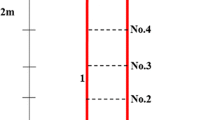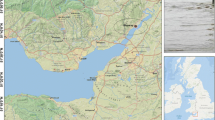Abstract
Surface charge distribution has great impact on interactions between sediment particles, which is essential for flocculation studies. In this paper, the micro-morphology and surface charge distribution of quartz sand are measured using the electrical force microscope. Then, the statistical relationship between micro-morphology and surface charge distribution is obtained. Results show that quartz sand possesses a complex surface morphology, which has great impact on the charge distribution. Positive and negative charges mostly concentrate in the saddle, convex, and concave parts of the surface, while their distribution is less in the groove, ridge, and flat parts. A fitting equation between surface charge and non-spherical curvature is also obtained. The surface charge distribution on a mathematical sediment particle is then reproduced according to these relations, and the effect of charge heterogeneity on interactions between different particles is quantified and analyzed, indicating that surface charge distribution has a dramatic effect on interactions between sediment particles, and local surface potential is more important than the average surface potential. This study provides a new method for understanding the processes of flocculation in coastal and estuarine zones.








Similar content being viewed by others
References
Abramowitz M, Stegun IA (1972) Handbook of mathematical functions. Dover, New York
Borgnino L, Avena M, De Pauli C (2006) Surface properties of sediments from two Argentinean reservoirs and the rate of phosphate release. Water Res 40:2659–2666
Carnie SL, Chan DYC, Stankovich J (1994) Computation of forces between spherical colloidal particles: nonlinear Poisson-Boltzmann theory. J Colloid Interface Sci 165:116–128
Chen ZH (2008) Experiment study on surface morphology and structural properties of sediment after copper ions adsorption. Dissertation, Tsinghua University
Dianoux R, Martins F, Marchi F (2003) Detection of electrostatic forces with an atomic force microscope: analytical and experimental dynamic force curves in the nonlinear regime. Phys Rev B 68:045403–045408
Drelich J, Jun L, Yeung A (2007) Determining surface potential of the bitumen-water interface at nanoscale resolution using atomic force microscopy. Can J Chem Eng 85:625–634
Fang HW, Chen MH, Chen ZH (2009) Surface characteristics and model of environmental sediment. Science Press, Beijing
Feick JD, Velegol D (2000) Electrophoresis of spheroidal particles having a random distribution of zeta potential. Langmuir 16:10315–10321
Grant ML, Saville DA (1995) Electrostatic interactions between a nonuniformly charged sphere and a charged surface. J Colloid Interface Sci 171:35–45
Han L (1999) Nano fabrication using scanning probe microscope. Tsinghua University, Dissertation
Hogg R, Healy TW, Fuerstenau DW (1966) Mutual coagulation of colloidal dispersions. Trans Faraday Soc 62:1638–1651
Huang L, Fang HW, Chen MH (2012) Experiment on surface charge distribution of fine sediment. Sci China Ser E 55:1146–1152
Kirkwood JG (1934) Theory of solutions of molecules containing widely separated charges with special application to zwitterions. J Chem Res 2:351–361
Li Y, Qian JQ, Xu P et al (2006) Design and research of phase imaging-mode atomic force microscopy. J of Chin Electron Microsc Soc 25:341–344 (in Chinese)
Magonov SN, Elings V, Whangbo MH (1997) Phase imaging and stiffness in tapping-mode atomic force microscopy. Sur Sci 375:L385–L391
Mei XM, Huang JZ (2008) Differential geometry, 4th edn. Higher Education Press, Beijing
Sader JE, Lenhoff AM (1998) Electrical double-layer interaction between heterogeneously charged colloidal particles: a superposition formulation. J Colloid Interface Sci 201:233–243
Sennato S, Truzzolillo D, Bordi F et al (2009) Colloidal particle aggregates induced by particle surface charge heterogeneity. Colloid Surf A-Physicochem Eng Asp 343:34–42
Stumm W (1992) Chemistry of the solid-water interface. Wiley, New York
Taboada-Serrano P (2005) Colloidal interactions in aquatic environments: effect of heterogeneity and charge asymmetry. Dissertation, Georgia Institute of Technology
Taboada-Serrano P, Vithayaveroj V, Yiacoumi S, Tsouris C (2005) Surface charge heterogeneities measured by AFM. Environ Sci Technol 39:6352–6360
Tan SS, Robert LS, Qin DQ (2005) Surface heterogeneity of polystyrene latex particles determined by dynamic force microscopy. Langmuir 21:43–49
Tang HX, Qian Y, Wen XH (2000) Characteristics and control technologies of water particles and refractory organics. China Environmental Science Press, Beijing
Tang GA, Liu XJ, Yan GN (2005) Principles and methods of digital elevation models and ground analysis. Science Press, Beijing
Velegol D, Thwar PK (2001) Analytical model for the effect of surface charge nonuniformity on colloidal interactions. Langmuir 17:7687–7693
Wang FY, Chen JS, Chen JL (1997) Surface properties of natural aquatic sediments. Water Res 31:1796–1800
Yang YY, Tang HM (2005) Measurement of chitosan material surface charge distribution using scanning probe microscope. J Mater Sci Eng 23:605–608 (in Chinese)
Yin XH, Drelich J (2008) Surface charge microscopy: novel technique for mapping charge-mosaic surfaces in electrolyte solutions. Langmuir 24:8013–8020
Zhao HB, Han L, Wang XF (2007) A new measurement system based on EFM for charges on dielectric surface in micro-nanometre scale. Insulating Mater 40:66–68 (in Chinese)
Acknowledgments
This research has been made possible with the support of the National Natural Science Foundation of China, grant no. 50909095, and Chinese Universities Scientific Fund, grant no. 2011JS131.
Author information
Authors and Affiliations
Corresponding author
Additional information
Responsible Editor: Andrew James Manning
This article is part of the Topical Collection on the 11th International Conference on Cohesive Sediment Transport
Rights and permissions
About this article
Cite this article
Chen, Mh., Fang, Hw. & Huang, L. Surface charge distribution and its impact on interactions between sediment particles. Ocean Dynamics 63, 1113–1121 (2013). https://doi.org/10.1007/s10236-013-0641-1
Received:
Accepted:
Published:
Issue Date:
DOI: https://doi.org/10.1007/s10236-013-0641-1




